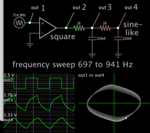neazoi
Advanced Member level 6
Hi I have an MCU (atmega644p) and I want to generate DTMF tones using it.
I can use only two pins for that, so external resistor ladder DA converters are not an option.
I could generate each of the two tones for each DTMF key by setting the pins high and low at specific time intervals. However this would generate square waves.
So I wonder, how tolerant are telephone companies in the purity of the DTMF tones?
I can use only two pins for that, so external resistor ladder DA converters are not an option.
I could generate each of the two tones for each DTMF key by setting the pins high and low at specific time intervals. However this would generate square waves.
So I wonder, how tolerant are telephone companies in the purity of the DTMF tones?
